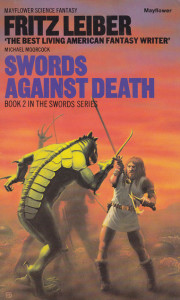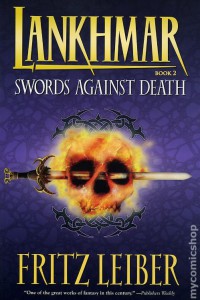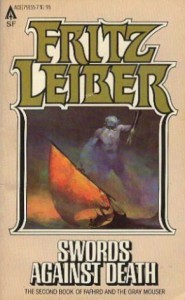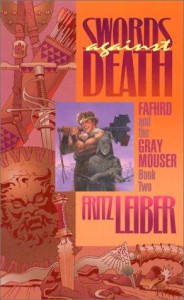Swords Against Death Re-Read: “The Price of Pain-Ease”
 Bill Ward and I are re-reading a book from Fritz Leiber’s famous Lankhmar series, Swords Against Death. We hope you’ll pick up a copy and join us. This week we tackled the ninth tale in the volume, “The Price of Pain-Ease.”
Bill Ward and I are re-reading a book from Fritz Leiber’s famous Lankhmar series, Swords Against Death. We hope you’ll pick up a copy and join us. This week we tackled the ninth tale in the volume, “The Price of Pain-Ease.”
 Howard: I have mixed feelings about this one. I think as a younger man I didn’t fully appreciate it. It’s clearly written at a later date because Leiber’s style has changed. The prose wanders a bit, the sentences are lengthier and more languid, and there’s frequently a sense of distance between reader and characters. Yet it still works. This story is polished to a high gloss.
Howard: I have mixed feelings about this one. I think as a younger man I didn’t fully appreciate it. It’s clearly written at a later date because Leiber’s style has changed. The prose wanders a bit, the sentences are lengthier and more languid, and there’s frequently a sense of distance between reader and characters. Yet it still works. This story is polished to a high gloss.
Bill: This is the story that finally made me go and check the chronology of the tales, as you say you can spot the style change. The piece is in a way a sequel to “Ill Met in Lankhmar,” and it, “Ill Met,” and “The Circle Curse” were all published in 1970, which is the year Swords Against Death and Swords and Deviltry appeared. (The “next” three books in the series appeared two years earlier[!], and contained stories written in the ’60s). I like Leiber’s style of this era. It isn’t until the ’70s that I start unfavorably comparing him with his earlier self. “High gloss” is an apt description.
Howard: I missed the banter I saw in some of my favorite stories, but I loved the color and description. I missed the more direct depictions of action, but I loved the inventiveness. I don’t think I’d rank it above my favorites from this volume, and certainly not above the upcoming “Bazaar of the Bizarre,” but it’s stronger stuff than the weakest entries in Swords Against Death.
Bill: One thing that is really apparent is Leiber knowing these characters inside and out at this point. The bantering isn’t there in this one, but there are all sorts of great character asides (how each keeps his room, the differences in their relationship to their past loves, the different paths they individually take to the Shadowlands) that really help set them apart. Plus, I just love that these guys actually stole themselves a house! I found the beginning of the story for this reason the most satisfying, the confrontation with death (the weird tales climax of a “swords & sorcery tale”) is essentially a punch line. It’s these two perpetual rogues, introduced to us as complete and, essentially, homeless outsiders, and their inability to domesticate themselves without literally being haunted by the ghosts of their former lovers that’s really where all the narrative weight lies. This time, the resolution is less important than what the basic problem says about our heroes. Which feels like a natural progression in any series, as the characters take on increasing importance.
 Howard: I hadn’t thought about it like that — a good observation.
Howard: I hadn’t thought about it like that — a good observation.
As for criticisms, perhaps it’s a little too convenient that the duke arrives to cut the mask perfectly in half (one wonders why he did that — was he aiming at the heroes and missed?) and I found myself asking why Fafhrd could object to Vlana being older than him by ten years — she’s been dead for a while now, so unless her ghost continued to age, wouldn’t their age be more approximate? On the other hand, I was reminded here why the Mouser continually has a kind of icky fascination with women who are just a little too young in later stories — it’s because of the age of his Ivrian when he first fell in love with her.
I’ve noticed that although Leiber claimed to have identified most with Fafhrd and that Mouser was supposed to be his friend (and co-creator) Harry Otto Fischer that a little more narrative time is usually given to the Mouser.
 Bill: Absolutely, I’ve noticed that as well and always thought it was odd that Leiber was supposed to ‘be’ Fafhrd. Maybe it is, after all, easier to write about “someone else.” But in nearly all of these stories GM does seem to dominate the point of view. He’s definitely come to Fafhrd’s rescue more often than not — although I happen to know that the reverse is true in next week’s “Bazaar of the Bizarre.”
Bill: Absolutely, I’ve noticed that as well and always thought it was odd that Leiber was supposed to ‘be’ Fafhrd. Maybe it is, after all, easier to write about “someone else.” But in nearly all of these stories GM does seem to dominate the point of view. He’s definitely come to Fafhrd’s rescue more often than not — although I happen to know that the reverse is true in next week’s “Bazaar of the Bizarre.”
Howard: Stay tuned — even Leiber himself named the last tale in the book one of his very favorite Lankhmar stories. I know “Bazaar of the Bizarre” is one of the more frequently anthologized, and it’s certainly high up the list of the best with me as well.

7 Comments